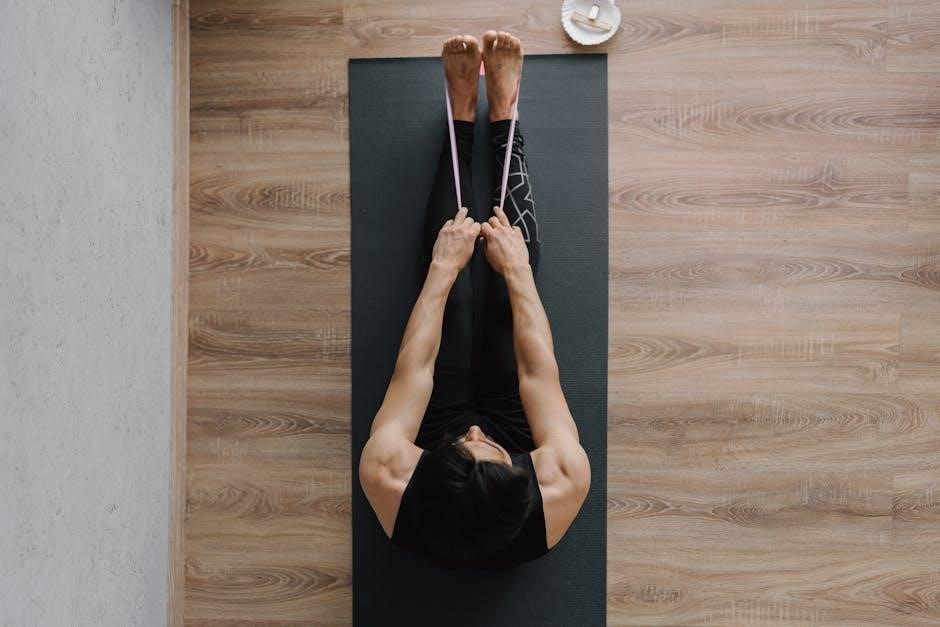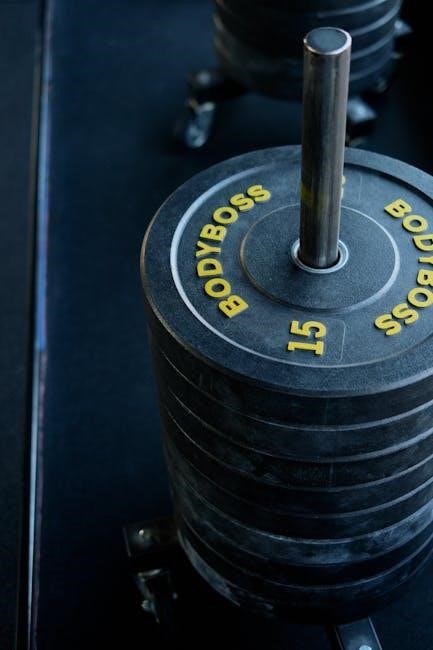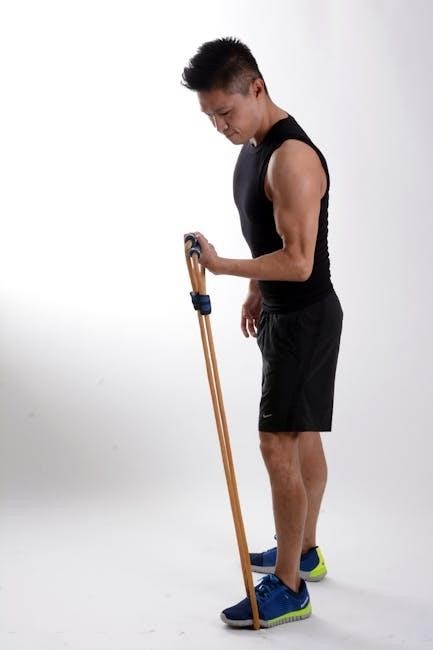Resistance band chest exercises offer a versatile, portable, and cost-effective way to build strength and muscle. They provide consistent resistance throughout exercises, targeting the chest effectively.
What Are Resistance Bands?
Resistance bands are lightweight, flexible straps or tubes designed to provide resistance during exercises. They come in various styles, such as looped bands, tube bands with handles, or figure-eight bands. Made from materials like rubber, latex, or fabric, they offer adjustable tension levels to suit different fitness goals. Portable and versatile, resistance bands are ideal for full-body workouts, including chest exercises. They mimic the action of weights but are easier to carry and use anywhere. With multiple resistance levels available, they cater to beginners and advanced users alike. Popular for their affordability and convenience, resistance bands are a great alternative to traditional gym equipment, making them a staple in home and travel workouts. PDF guides often include detailed exercises for chest development using these bands.
Benefits of Using Resistance Bands for Chest Workouts
Resistance bands offer a cost-effective, portable, and versatile way to strengthen the chest muscles. They provide consistent tension throughout exercises, engaging the chest effectively. Unlike free weights, bands are lightweight and easy to carry, making them ideal for home or travel workouts. They also allow for a full range of motion, reducing the risk of injury compared to heavy weights. With multiple resistance levels available, bands cater to all fitness levels, from beginners to advanced users. Additionally, they enable exercises that target multiple muscle groups simultaneously, enhancing efficiency. Their versatility makes them a valuable tool for achieving a well-rounded chest workout. PDF guides often highlight these benefits, offering detailed routines for chest development using resistance bands.

Why Resistance Bands Are Effective for Chest Development
Resistance bands provide constant tension, engaging the chest muscles fully. They allow for a full range of motion, targeting multiple muscle groups effectively. Portable and versatile, they enhance workouts. PDF guides often highlight these benefits for chest development.
Science Behind Resistance Band Training
Resistance band training leverages elastic resistance, where force increases with stretch. This constant tension engages muscles fully, enhancing strength and hypertrophy. Unlike free weights, bands provide variable resistance, peaking at full extension.
This mimics natural muscle actions, promoting functional strength. The stretch reflex activates more muscle fibers, especially in the chest, making exercises like chest presses and flies highly effective.
Research shows that elastic bands can match or exceed the effectiveness of traditional weights for building muscle. They also improve joint stability and reduce injury risk due to controlled movement.
For chest development, the continuous tension ensures maximum engagement of the pectoralis muscles throughout exercises. PDF guides often detail these scientific principles for optimal workouts.

How Resistance Bands Compare to Traditional Weights
Resistance bands and traditional weights differ in how they apply force. Bands provide elastic resistance, increasing tension as they stretch, while weights rely on gravity. This makes bands portable and versatile for chest exercises like presses and flies.
Bands engage muscles dynamically, promoting functional strength and joint stability. They are ideal for hypertrophy and endurance training but may lack the intensity of heavy weights for pure powerlifting.
Despite this, studies show bands can match or exceed weights for muscle growth when used correctly. They are also lower-cost and space-efficient, making them a practical alternative for home or travel workouts. For detailed routines, view the PDF guide.

Basic Resistance Band Chest Exercises
Master foundational moves like chest presses, flies, and banded push-ups to target your chest effectively. These exercises are perfect for building strength and muscle mass at home or on the go.
The PDF guide offers detailed workout plans to help you get started with these essential exercises and progress safely.
Chest Press
The chest press is a fundamental resistance band exercise that targets the pectoralis muscles. To perform it, loop the band under your feet and hold the ends in each hand. Press the band forward, extending your arms fully, then return to the starting position. Keep your chest lifted and core engaged throughout the movement. This exercise mimics a bench press but is more portable and affordable. For variation, you can adjust the resistance level by changing the band’s tension or combining it with other exercises. The PDF guide provides detailed steps and progressions for mastering the chest press effectively.
Chest Fly
The chest fly is an excellent resistance band exercise for targeting the pectoralis muscles, improving chest development and flexibility. To perform it, loop the band at chest height and face away from the anchor point. Hold the ends of the band in each hand, with your arms extended to the sides at shoulder height. Inhale as you pull the band apart, bringing your arms forward until they meet in front of you. Exhale and slowly return to the starting position. Keep your core engaged and maintain control throughout the movement. This exercise is ideal for isolating the chest muscles and can be adjusted by changing the band’s resistance level. For detailed instructions, refer to the PDF guide.
Push-Ups with Resistance Bands
Push-ups with resistance bands enhance traditional push-ups by adding extra resistance, targeting the chest, shoulders, and triceps. Place the band across your upper back and hold each end with your hands. Perform a push-up, lowering your chest to the ground while maintaining proper form. The band increases tension, engaging your muscles more intensely. This variation helps build strength and improves chest development. Adjust the band’s resistance level to suit your fitness goals. For a detailed guide and variations, refer to the PDF guide.

Intermediate Resistance Band Chest Exercises
Intermediate exercises like incline chest press, decline chest press, and chest press with rotation target the chest from multiple angles, enhancing muscle development and strength. Use the PDF guide for detailed instructions.
Incline Chest Press
The incline chest press targets the upper chest muscles, enhancing definition and strength. Anchor the resistance band above chest height and press forward, extending your arms fully. Maintain proper form by keeping your chest lifted and core engaged throughout the movement. This exercise can be modified by adjusting the angle of incline or using different resistance levels. For detailed guidance, refer to the PDF guide, which provides step-by-step instructions and variations to maximize results.
Decline Chest Press
The decline chest press focuses on the lower chest muscles, helping to create a balanced and defined chest. To perform, anchor the resistance band behind you at a lower height. Sit or stand with the band secured under your shoulders, then press forward, extending your arms fully. Keep your core tight and chest lifted to maintain proper form. This exercise can be intensified by increasing the resistance level or adding rotations. For a comprehensive workout plan, download the PDF guide, which includes detailed instructions and variations.
Chest Press with Rotation
The chest press with rotation combines a chest press with a rotational movement, engaging both the chest and shoulders. Anchor the band at chest height, facing away, and hold the ends. Press the band forward while rotating your hands outward, extending your arms fully. Keep your core tight and chest lifted to maintain form. This exercise enhances chest development and improves shoulder mobility. For added intensity, increase resistance or incorporate pauses. It’s an effective variation for targeting multiple muscle groups simultaneously. Detailed instructions and variations can be found in the PDF guide.

Advanced Resistance Band Chest Exercises
Advanced exercises like single-arm presses and rotational movements challenge the chest, shoulders, and core. These techniques require precise control and form to maximize results effectively.
Single-Arm Chest Press
The single-arm chest press is an advanced exercise that isolates one side of the chest, improving unilateral strength and balance. Anchor the band at chest height. Hold one end in your working hand, facing away from the anchor. Press the band forward, extending your arm fully, then return to the starting position. This exercise targets the pectoralis major, engaging the shoulders and core for stability. It helps identify and correct muscle imbalances while enhancing overall chest development. Maintain proper form to avoid injury and maximize results. Variations include changing resistance levels or angles for added challenge.
Resistance Band Chest Fly with Rotation
The resistance band chest fly with rotation is an advanced exercise that combines the chest fly movement with a rotational component for enhanced engagement. Anchor the band at chest height and hold both ends. Stand facing the anchor point, then press the band forward while rotating your hands outward. This movement targets the pectoralis major and minor muscles, promoting balanced chest development. The rotation adds an extra challenge, engaging the shoulders and improving flexibility. Maintain tight core engagement to prevent swaying and ensure proper form. Progress by increasing resistance or adding more rotations. This exercise is ideal for building a broader, more defined chest while improving overall upper body mobility.
Pallof Press for Chest Development
The Pallof press is a highly effective resistance band exercise for chest development, emphasizing stability and strength; Anchor the band at chest height and hold both ends with your hands. Press the band away from your body, extending your arms fully while maintaining a neutral spine. Focus on squeezing your chest muscles during the press. This exercise targets the pectoralis major and minor, improving chest strength and definition. Incorporate variations like half-kneeling or rotational presses to enhance engagement. Gradually increase resistance by using thicker bands or stepping further from the anchor. Regular Pallof presses can improve posture and overall chest aesthetics, making them a valuable addition to any chest workout routine.

How to Structure a Resistance Band Chest Workout
Start with a dynamic warm-up, including arm circles and chest-opening stretches using light resistance. Perform basic exercises like chest presses and flys, then progress to incline or decline presses. Alternate between push and pull movements. Aim for 3-4 sets of 8-12 reps for strength or higher reps for endurance. Conclude with static stretches for the chest, shoulders, and triceps to improve flexibility and reduce soreness. Keep the workout focused, lasting 45 minutes to an hour, ensuring effective targeting of chest muscles while maintaining intensity and preventing injuries.
Warm-Up Routine
A proper warm-up is essential to prepare your muscles for resistance band chest exercises. Begin with dynamic stretches, such as arm circles, chest opens, and shoulder rolls, to increase blood flow. Use light resistance from the band to perform gentle presses and flys, focusing on controlled movements. Incorporate light cardio, like jumping jacks or bodyweight squats, to elevate your heart rate. Dedicate 5-10 minutes to this routine to prevent injury and enhance muscle activation. Avoid static stretching at this stage, as it can reduce power and flexibility during the workout. Instead, focus on movements that mimic the exercises you’ll perform, ensuring your chest, shoulders, and triceps are ready for the workout ahead.
Exercise Order and Timing
Start your resistance band chest workout with compound exercises like chest presses and push-ups, as they engage multiple muscle groups and build foundational strength. Follow with isolation exercises, such as chest flys, to target specific areas. Aim for 3-4 sets of 8-12 repetitions per exercise, resting for 60-90 seconds between sets for strength gains or 30-60 seconds for endurance. Maintain consistent pacing to keep your heart rate elevated and maximize efficiency. Gradually increase resistance or repetitions as you progress. Timing your workout ensures balanced development and prevents overtraining. Incorporate variations, such as rotational presses, to keep the routine dynamic and effective.
Cool-Down Stretches
A proper cool-down after resistance band chest exercises is essential for muscle recovery and flexibility. Begin with a chest stretch: stand in a doorway with arms extended overhead, leaning forward until a gentle stretch is felt. Hold for 20-30 seconds. Next, perform shoulder stretches to relieve tension, holding each for 30 seconds. Incorporate cat-cow stretches to improve spinal mobility and reduce stiffness. Finish with deep breathing exercises to relax your muscles and lower your heart rate. Aim to spend 5-10 minutes on cool-down stretches to enhance recovery and prevent soreness. Adjust the routine based on your specific workout intensity and needs.

Progression and Scaling in Resistance Band Workouts
Progression involves increasing resistance levels and incorporating compound movements. Scaling can be achieved by combining chest exercises with other muscle groups for a full-body workout.
Increasing Resistance Levels
Progression in resistance band workouts is achieved by increasing tension. Swap lighter bands for thicker ones or layer multiple bands for added resistance. Adjusting anchor points, such as moving further from the attachment, also intensifies workouts. Incorporating isometric holds or slower tempos enhances muscle engagement. Tracking progress through increased reps or resistance levels ensures continuous improvement. Combining chest exercises with compound movements targets additional muscle groups for a comprehensive workout. This scalable approach allows users to gradually build strength and muscle without requiring heavy equipment, making resistance bands a versatile tool for long-term fitness goals.
Incorporating Other Muscle Groups
Resistance band chest exercises can be enhanced by engaging other muscle groups. Compound movements like chest presses and flyes naturally involve the shoulders and triceps. To expand further, combine chest exercises with rows or shoulder presses to target the back and deltoids. Rotational movements, such as the Pallof press, incorporate the core for stability. This integrated approach not only enhances chest development but also improves overall upper body strength and coordination. By incorporating other muscle groups, workouts become more efficient and functional, promoting balanced muscle growth and better athletic performance. This holistic method ensures a comprehensive fitness routine with minimal equipment.

Safety Tips for Resistance Band Chest Exercises
Always inspect bands for damage before use. Start with a dynamic warm-up to prevent muscle strains. Use full range of motion and controlled movements. Anchor bands securely to avoid accidents. Adjust resistance according to fitness level. Focus on breathing to maintain form and stability.
Proper Form and Technique
Proper form is essential for maximizing results and preventing injuries during resistance band chest exercises. Stand tall with your chest lifted and shoulders back to maintain a neutral spine. Engage your core to stabilize your body throughout each movement. Keep your movements controlled and avoid jerky actions, as this can strain muscles. Ensure the band is at the correct height for the exercise to maintain tension without overstretching. Focus on full range of motion to effectively target the chest muscles. Avoid arching your back or letting your shoulders roll forward, as this can lead to poor form and potential injury. Smooth, deliberate transitions between phases of the exercise help prevent muscle strain. Always prioritize a dynamic warm-up to prepare your muscles for the workout.
Preventing Injuries
Preventing injuries during resistance band chest exercises requires attention to proper technique and equipment care. Always inspect the band for wear or damage before use. Avoid overstretching the band, as this can cause sudden snaps. Start with lighter resistance and gradually increase as your strength improves. Never sacrifice form for heavier resistance, as poor mechanics can lead to muscle strains. Keep movements slow and controlled, avoiding jerky or bouncy actions. Ensure the band is anchored securely to prevent it from slipping during exercises. Maintain proper breathing patterns—inhale during relaxation phases and exhale during exertion. Stop immediately if you experience pain or discomfort.

Resources for Resistance Band Chest Exercises
Discover downloadable PDF guides, detailed workout plans, and online forums for resistance band chest exercises. Mobile apps also offer tracking tools and customizable routines for optimal results.
PDF Guides and Workout Plans
Downloadable PDF guides provide detailed resistance band chest exercise routines, including step-by-step instructions and visual aids. These resources often feature customizable workout plans tailored to different fitness levels. Many guides include variations of exercises like chest presses, flies, and rotations, ensuring comprehensive chest development. Some PDFs also offer progressive overload strategies to help users gradually increase intensity. Websites like Google Drive and wellness programs often share these guides for free, making them accessible to everyone. They are ideal for structuring home workouts or gym sessions, ensuring consistency and progress in building chest strength and muscle effectively.
Online Communities and Forums
Online communities and forums are excellent resources for discovering resistance band chest exercises. Platforms like Reddit, Facebook groups, and specialized fitness forums offer extensive discussions, shared routines, and expert advice. Many users post their favorite exercises, progress stories, and tips for maximizing chest development with bands. These communities provide real-time interaction, allowing you to ask questions and receive personalized feedback. Additionally, they often share PDF guides and workout plans, making it easier to find structured routines. Engaging with these forums can help you stay motivated, learn new techniques, and connect with others who share your fitness goals; They are invaluable for both beginners and advanced users seeking inspiration or guidance.
Mobile Apps for Workout Tracking
Mobile apps are fantastic tools for tracking resistance band chest workouts. Apps like Nike Training Club and JEFIT offer customizable workout plans, including chest exercises using resistance bands. They provide video tutorials, step-by-step instructions, and progress tracking features. Many apps allow users to download PDF guides for offline access, ensuring workouts can be done anywhere. These apps also enable users to set fitness goals, log exercises, and monitor improvements over time. Additionally, some apps offer social features to share routines and connect with fitness communities. By leveraging these apps, individuals can stay organized, motivated, and consistent with their resistance band chest exercises, making their fitness journey more effective and enjoyable.




